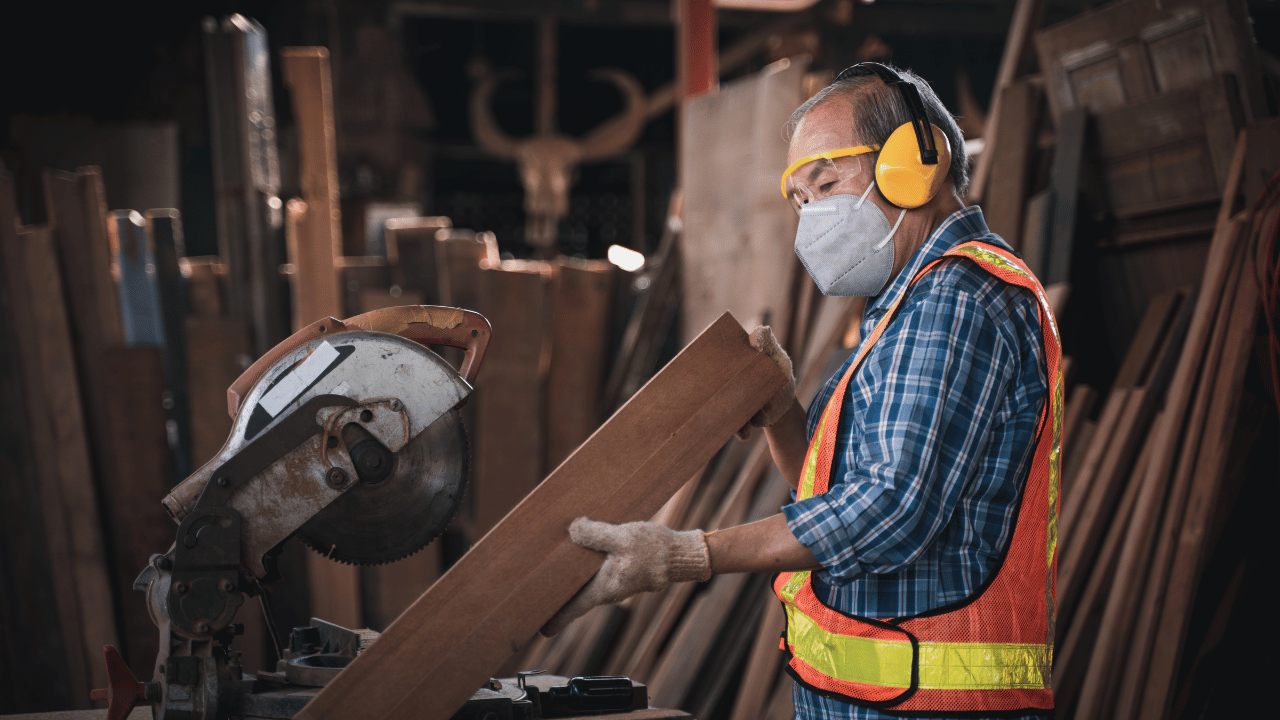Last Updated on October 10, 2023 by Pro Handyman Australia – Editorial Team
In the realm of carpentry, a strong foundation in mathematics, particularly geometry, is indispensable. Before diving into projects, it’s crucial to refresh your math skills. Whether you’ve always found math daunting or just need a refresher, numerous online math tutorials are available. These tutorials not only enhance understanding but also guide you through problem-solving techniques pivotal for woodworking.
Immersing in Literature and Publications To truly embrace the world of carpentry, one must delve into its vast literature. For beginners, numerous books, magazines, and journal articles shed light on the intricacies of the trade. They not only introduce the basics but also keep enthusiasts updated on the latest industry advancements. A simple online search or a visit to the local library can unveil a treasure trove of carpentry knowledge. For a broader perspective, consider reading about architecture, focusing especially on the rich classical traditions.
Leveraging the Power of Online Tutorials The digital age has made learning any craft, including carpentry, remarkably convenient. Platforms like YouTube are replete with videos demonstrating a range of carpentry projects. Whether you’re trying to master the art of measuring wood or aspiring to construct an entire shed, there’s likely a tutorial for it. However, a word to the wise: always gravitate towards videos produced by licensed carpenters. This ensures the techniques you’re learning are both safe and rooted in professional expertise.
By acquainting yourself with these foundational methods and resources, you’re well on your way to mastering the art and craft of carpentry. Embrace the journey of continuous learning and skill enhancement, and let the world of woodworking unveil its wonders to you.
Embarking on a Carpentry Career

Educational Foundations To build a strong foundation for a carpentry career, it’s crucial to obtain a high school diploma. Aspiring carpenters can greatly benefit from subjects like mathematics, mechanical drawing, and woodworking during their high school years. Gaining practical experience is equally important; thus, it’s a wise move to work as a carpenter’s helper either during high school or immediately after graduation. This role offers firsthand experience with tools and techniques that carpenters use daily. Moreover, upon finishing high school, it’s advisable to pursue an official apprenticeship program. This progression allows one to achieve the status of a journeyman carpenter, opening doors to superior remuneration and a broader range of job opportunities.
The Apprenticeship Journey An apprenticeship is a comprehensive blend of technical training and on-the-job experience. Over the course of this typically four-year program, apprentices can anticipate:
- Engaging in approximately 144 hours of technical training annually.
- Accumulating around 2,000 hours of paid hands-on experience each year.
The curriculum of these programs is robust, covering essential topics such as carpentry fundamentals, blueprint interpretation, mathematical applications, and understanding building code stipulations. Practical training segments delve into areas like metal stud framing, safety protocols, and first aid practices. Some programs may also provide specialized instruction in areas like concrete form setting, rigging, welding, scaffold construction, and strategies for working in confined spaces.
Safety is paramount in carpentry, and hence, all carpenters must successfully complete the 10- and 30-hour safety courses mandated by the Occupational Safety and Health Administration (OSHA).
Foundations of Woodworking: Key Techniques Unraveled

The Art of Milling
Milling transforms rough lumber into geometrically accurate blocks, laying the foundation for any woodworking project. This process initiates at the jointer, with the aim of flattening one face of the board. Following this, a planer smoothens the opposite face. The culmination of this process is at the table saw, where the board is cut to ensure parallelism between its edges. This meticulous preparation is pivotal for subsequent joinery.
Understanding Jointing and Planing
Jointing is integral to the milling process and involves the flattening of one face and edge of the wood. On specific occasions, the jointer serves additional roles in tasks such as rabbeting, beveling, and tapering.
Planing, on the other hand, streamlines wooden surfaces by removing excess material. After an initial face is smoothed using the jointer, a planer ensures uniform thickness across the lumber. The choice between hand planing or using an electric planer depends on the project. Hand planes offer precision, produce minimal dust, and function silently. Electric planers, conversely, are suitable for extensive material removal in minimal time.
Sawing: From Basics to Precision

Almost invariably, a woodworking endeavor begins with the act of sawing. Given the diversity of projects, a plethora of saw types exist, each tailored for specific tasks. Adhering to safety measures, such as wearing protective glasses, respiratory masks, and hearing protection, is indispensable when operating saws.
Chop Saw: Also known as the sliding compound miter saw, it is predominantly used to cut lumber into manageable sizes. Besides being effective for angular cuts, its precision can be augmented using a table saw jig.
Hand Saw: These are versatile and do not rely on a power source. Western saws are robust, designed for forceful push-throughs, whereas Japanese hand saws, with their thinner blades, require a gentle pull and are relatively user-friendly.
Portable Circular Saw: Recognized for their efficiency and portability, these saws are ideal for rapid cuts.
Table Saw: As a staple in many woodshops, table saws are both powerful and precise. They cater to a myriad of operations, courtesy of assorted jigs and blades. However, users should remain wary of kickbacks, which can result in loss of control over the workpiece.
Chainsaw: Typically utilized for initial rough cuts or material sourcing from tree felling, chainsaws can be powered by gasoline, electricity, or batteries.
Bandsaw: Suited for rough ripping, curved cuts, and “stopped” cuts, bandsaws offer flexibility based on stock size and project intricacy. However, their cuts might be rougher than those from a table saw.
Scroll Saw: Perfect for delicate curves and intricate designs, scroll saws employ a slender blade to execute meticulous cuts.
Drilling and Boring

Drilling and boring are complementary processes in woodworking and even tasks like how to drill a hole in glass. While drilling initiates the creation of holes in wood, boring serves to enlarge these pre-existing apertures. The choice of device – be it a handheld drill driver for its versatility or a stationary drill press for its precision – relies on the desired outcome. Remember, the bit attached to your drill should be compatible with the material and size of the hole.
Diving into Drill Bits
Selecting the right drill bit hinges on several factors: the size of the hole, the material you’re working with, and the speed of operation. Before diving into classifications, one might wonder what is a jobber drill bit. Broadly, drill bits can be classified into three categories:
- Twist Bits: Universally employed, twist bits find a place in most woodworkers’ toolkits.
- Forstner Bits: Ideal for carving out large, refined holes.
- Spade Bits: An economical choice for crafting expansive holes, but with the potential downside of splintering or causing tear-out.
Mastering the Drill Press
Equipped to deliver precision-driven holes, the drill press supports a spectrum of bits. Optimal usage involves matching the bit size with the correct speed; while smaller bits operate efficiently at high speeds, their larger counterparts demand a slower pace. It’s essential to exercise caution: forcing the drill or overly rapid feeding can cause bits to break. Periodic withdrawal of the drill during extended operations ensures both cleanliness and cooling.
The World of Routing

Routers, with their dual utility as handheld tools and table-mounted devices, are invaluable. Depending on the selected bit, routers can be harnessed for myriad tasks, including grooving, pattern following, and edge treatment. For woodworkers operating in compact spaces or at the dawn of their journey, a router proves to be a worthwhile investment.
Gluing and Clamping: Joining Forces
Understanding Glue Types: Achieving a bond that’s mightier than the wood itself, glue is a woodworker’s ally. Predominantly, three types of glue are prevalent:
- Interior Glue (White & Yellow): Frequently employed, this glue variant isn’t water-resistant, making it unsuitable for outdoor applications.
- Exterior Glue: Catering to outdoor projects, it boasts water-resistance.
- Epoxy: Renowned for gap-filling and amplifying the sturdiness of an assembly.
Exploring Clamps: The realm of clamps is expansive, each designed to fulfill specific requirements:
- Bar Clamps: Ideal for sizeable projects, they sport adjustable widths and are available in diverse sizes.
- Pipe Clamps: Echoing the utility of bar clamps, pipe clamps are adaptable, with length adjustments achieved by altering the intervening pipe.
- F-Clamps: Perfect for slender projects, they offer swift edge clamping and can serve as makeshift vises.
- Spring-loaded Clamps: Suitable for petite projects, these are uncomplicated to use and feather-light.
Shaping, Molding, and Beyond
Shaping breathes life into wood, transforming it into non-standard structures. In contrast, molding involves crafting decorative wooden strips that beautify transitional surfaces. Additionally, woodworkers often harness steam’s prowess to craft graceful curves in wood slivers.
The Intricacy of Scrollwork
Scrollwork is the craft of producing ornate designs in wood using a specialized tool – the scroll saw. From lettering to elaborate furniture appendages, the scope of scrollwork is vast.
The Beauty of Lathe Turning
Woodturning is the craft of molding wood into cylindrical structures using a lathe. Here, enthusiasts learn the fundamentals, from sharpening and wood selection to finishing techniques.
Veneering and Lamination: Layered Excellence
Veneering involves accentuating a wooden surface with thin slices, often utilized in the art of marquetry. On the other hand, lamination melds layers of wood through glue and pressure. A quintessential application of this technique is the creation of skateboards, where layers of hard maple veneer are seamlessly blended.
Mastering the Art of Sanding and Filing

Sanding and filing are foundational techniques in the realm of woodworking, each serving a distinct purpose in refining wooden surfaces.
Sanding: This method primarily focuses on smoothing the wooden surface. The key is employing sandpaper in ascending grit sequences. As you graduate to finer grits, the scratches left on the wood become imperceptible. It’s essential to understand the grit grading; higher numbers denote finer particles, ensuring a smoother finish.
Filing: Contrarily, filing leans towards eliminating rough patches and sculpting wood in challenging angles. Files, crafted from hardened steel and coupled with a wooden handle, become instrumental here. Their counterparts, rasps, function similarly but expedite material removal, albeit at the expense of a rougher finish.
The Nuances of Hand Sanding
For the most part, hand sanding finds its best companion in a block. Exceptions arise when dealing with curves or when beveling edges. It’s vital to maintain a consistent pressure and to sand along the grain, as this approach masks any inadvertent scratches. For sculpted or curved surfaces, simply folding the sandpaper and maneuvering it by hand often yields the best results.
Diving into Powered Sanding
Incorporating powered sanders can significantly expedite the sanding process, but they come with their own set of challenges. These tools, given their aggressive nature, can inadvertently introduce unevenness to the surface.
- Disc and Spindle Sanders: These robust tools, armed with coarse abrasives, are more suited for shaping than refining. While the disc variant is a boon for external curves and flat surfaces, the spindle sander, with its varied drum radii, is tailored for internal curves.
- Handheld Random Orbit Sanders: These tools, although handy for finishing, can inadvertently taper edges or create grooves due to their aggressive nature. As a rule of thumb, oscillating drum sanders should ideally be reserved for final touches with fine-grit sandpaper.
The Finishing Touch

Wood, being a natural substance, is susceptible to scratches, dents, and moisture-induced expansion or contraction. Implementing a finish not only protects the wood from these adversities but also elevates its aesthetic appeal by highlighting the grain.
Penetrating Finishes: Predominantly oil-based, these finishes seep into the wood, endowing it with a more organic appearance. Their application process is relatively straightforward.
Surface Finishes: These finishes solidify atop the wood, forming a resilient shield. Paint, polyurethane, and shellac fall into this category. Given their durability, they’re apt for items prone to frequent usage, such as patio furniture or kitchen countertops.
Expert Insight: When applying finishes, it’s crucial to ensure even the concealed sections of the wood are covered. This uniform application guarantees that the wood responds consistently to environmental humidity changes. Typically, one or two coats suffice for these hidden segments.
Finishing is a vast domain, replete with myriad techniques and preferences. This guide offers a glimpse into the foundational finishes and methods, equipping you with a solid foundation to begin your journey.
Woodworking: Essential Tips for Novices

Precision in Measurement Though it might sound repetitive, the age-old advice, “Measure twice, cut once,” holds invaluable merit. Ensuring accuracy in your measurements prior to any cuts can save both time and material.
Selecting the Ideal Wood Before diving into a project, it’s crucial to understand the variety of wood types available. Factors to consider include the drying method and duration. As wood undergoes the drying process, it can lose moisture, leading to potential shrinkage and shape alteration. Kiln-dried lumber stands out as a preferred choice due to its rigorous drying process, which minimizes warping. When working with damp wood, there’s a heightened risk of warping, and it may not be compatible with certain machinery.
Moreover, while timber is a replenishable asset, its harvesting practices may not always prioritize sustainability. It’s noteworthy that certain organizations prioritize sustainably-sourced North American hardwoods in their woodworking endeavors.
Inspecting for Wood Imperfections Wood defects might compromise not only the structural integrity of your project but also its aesthetics. Always be vigilant for any embedded nails, staples, or metallic fragments, as these could potentially harm your tools.
Maintaining a Tidy Work Area Integrate a consistent cleaning routine in your woodworking practice. Keep a broom near your saw stations to promptly clear away sawdust and periodically employ a shop vacuum to ensure a hazard-free environment.
Honing Skills Through Home Projects Engaging in practice projects is a constructive approach to acquaint oneself with diverse wood types, equipment, and techniques. For instance, some institutions offer foundational courses where students craft tools like a bench hook, which serves as a stabilizing tool for working on compact projects. Starting with beginner-friendly creations like a mini table, bookends, or shelves can pave the way for mastering the basics.
Seeking Formal Education Gleaning knowledge from professionals in the field can be immensely beneficial. Opting for classes in community woodshops can be both economical and enlightening, negating the need for establishing a personal workspace at home. Some renowned institutions in certain regions offer frequent courses, catering to varied proficiency levels.
Prioritizing Safety Safety remains paramount in woodworking. When operating with tools that generate sawdust or minute particles, it’s imperative to wear safety glasses or goggles along with a respirator. Equip yourself with earplugs or other hearing protection gear when using loud machinery. Undivided attention is essential when handling tools, so eliminate any potential distractions. Regular tool maintenance and ensuring their sharpness can streamline the woodworking process and mitigate the risk of injuries.
Conclusion

The intricate world of carpentry offers a blend of artistry, precision, and practicality, bridging creativity and utility. As we delved into the essential techniques of this craft, it became evident that mastering the basics lays the groundwork for more complex projects. Whether it’s the meticulousness required in measuring and cutting or the understanding of diverse wood types and their unique characteristics, these foundational skills underscore the significance of detailed craftsmanship. Moreover, ensuring safety and maintaining a well-organized workspace amplifies efficiency and fosters innovation. While carpentry might seem daunting at first, with the right knowledge, practice, and dedication, anyone can harness its myriad possibilities. Just as a house relies on a robust foundation, in carpentry, it’s these rudimentary techniques that empower artisans to sculpt, design, and redefine the boundaries of woodwork.
